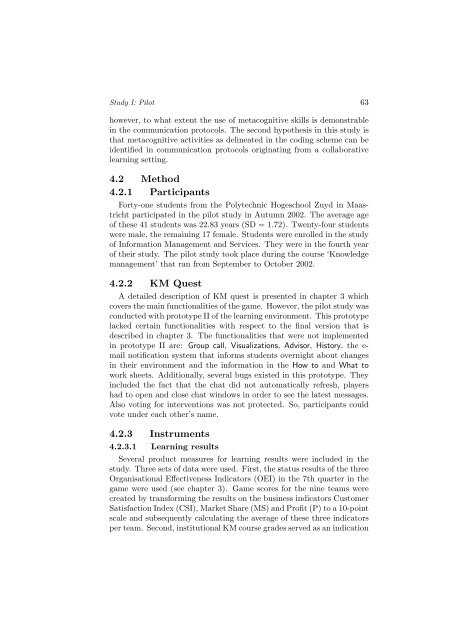The role of metacognitive skills in learning to solve problems
The role of metacognitive skills in learning to solve problems
The role of metacognitive skills in learning to solve problems
Create successful ePaper yourself
Turn your PDF publications into a flip-book with our unique Google optimized e-Paper software.
Study I: Pilot 63<br />
however, <strong>to</strong> what extent the use <strong>of</strong> <strong>metacognitive</strong> <strong>skills</strong> is demonstrable<br />
<strong>in</strong> the communication pro<strong>to</strong>cols. <strong>The</strong> second hypothesis <strong>in</strong> this study is<br />
that <strong>metacognitive</strong> activities as del<strong>in</strong>eated <strong>in</strong> the cod<strong>in</strong>g scheme can be<br />
identified <strong>in</strong> communication pro<strong>to</strong>cols orig<strong>in</strong>at<strong>in</strong>g from a collaborative<br />
learn<strong>in</strong>g sett<strong>in</strong>g.<br />
4.2 Method<br />
4.2.1 Participants<br />
Forty-one students from the Polytechnic Hogeschool Zuyd <strong>in</strong> Maastricht<br />
participated <strong>in</strong> the pilot study <strong>in</strong> Autumn 2002. <strong>The</strong> average age<br />
<strong>of</strong> these 41 students was 22.83 years (SD = 1.72). Twenty-four students<br />
were male, the rema<strong>in</strong><strong>in</strong>g 17 female. Students were enrolled <strong>in</strong> the study<br />
<strong>of</strong> Information Management and Services. <strong>The</strong>y were <strong>in</strong> the fourth year<br />
<strong>of</strong> their study. <strong>The</strong> pilot study <strong>to</strong>ok place dur<strong>in</strong>g the course ‘Knowledge<br />
management’ that ran from September <strong>to</strong> Oc<strong>to</strong>ber 2002.<br />
4.2.2 KM Quest<br />
A detailed description <strong>of</strong> KM quest is presented <strong>in</strong> chapter 3 which<br />
covers the ma<strong>in</strong> functionalities <strong>of</strong> the game. However, the pilot study was<br />
conducted with pro<strong>to</strong>type II <strong>of</strong> the learn<strong>in</strong>g environment. This pro<strong>to</strong>type<br />
lacked certa<strong>in</strong> functionalities with respect <strong>to</strong> the f<strong>in</strong>al version that is<br />
described <strong>in</strong> chapter 3. <strong>The</strong> functionalities that were not implemented<br />
<strong>in</strong> pro<strong>to</strong>type II are: Group call, Visualizations, Advisor, His<strong>to</strong>ry, the e-<br />
mail notification system that <strong>in</strong>forms students overnight about changes<br />
<strong>in</strong> their environment and the <strong>in</strong>formation <strong>in</strong> the How <strong>to</strong> and What <strong>to</strong><br />
work sheets. Additionally, several bugs existed <strong>in</strong> this pro<strong>to</strong>type. <strong>The</strong>y<br />
<strong>in</strong>cluded the fact that the chat did not au<strong>to</strong>matically refresh, players<br />
had <strong>to</strong> open and close chat w<strong>in</strong>dows <strong>in</strong> order <strong>to</strong> see the latest messages.<br />
Also vot<strong>in</strong>g for <strong>in</strong>terventions was not protected. So, participants could<br />
vote under each other’s name.<br />
4.2.3 Instruments<br />
4.2.3.1 Learn<strong>in</strong>g results<br />
Several product measures for learn<strong>in</strong>g results were <strong>in</strong>cluded <strong>in</strong> the<br />
study. Three sets <strong>of</strong> data were used. First, the status results <strong>of</strong> the three<br />
Organisational Effectiveness Indica<strong>to</strong>rs (OEI) <strong>in</strong> the 7th quarter <strong>in</strong> the<br />
game were used (see chapter 3). Game scores for the n<strong>in</strong>e teams were<br />
created by transform<strong>in</strong>g the results on the bus<strong>in</strong>ess <strong>in</strong>dica<strong>to</strong>rs Cus<strong>to</strong>mer<br />
Satisfaction Index (CSI), Market Share (MS) and Pr<strong>of</strong>it (P) <strong>to</strong> a 10-po<strong>in</strong>t<br />
scale and subsequently calculat<strong>in</strong>g the average <strong>of</strong> these three <strong>in</strong>dica<strong>to</strong>rs<br />
per team. Second, <strong>in</strong>stitutional KM course grades served as an <strong>in</strong>dication
















